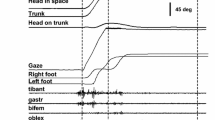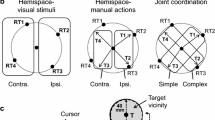Summary
The accuracy of pointing movements of the hand, directed at visual targets 10° to 40° from the midline, was measured in normal human subjects. No visual feedback from the moving hand was available to the subjects. The head could be either maintained stationary (head-fixed condition) or free to move (head-free condition) during the pointing movements. It was found that the error in pointing was reduced for all targets in the head-free condition. This reduction was more important for the more eccentric target (40°). Improvement in accuracy was observed without any significant change in either the latency or the duration of eye, head or hand movements. In the head-free condition, it was found that the head was displaced in the direction of the target by an amount representing no more than 2/3 of the target amplitude. The improvement in accuracy was not influenced by the amplitude of the head movement. A model is proposed which shows how coordinated eye and head movements could improve the encoding of target position.
Similar content being viewed by others
References
Biguer B, Jeannerod M, Prablanc C (1982) The coordination of eye, head and arm movements during reaching at a single visual target. Exp Brain Res 46: 301–304
Chernikoff R, Taylor FV (1952) Reaction time to kinesthetic stimulation resulting from sudden arm displacement. J Exp Psychol 43: 1–8
Cohen LA (1961) Role of the eye and neck proprioceptive mechanisms in body orientation and motor coordination. J Neurophysiol 24: 1–11
Glencross DJ (1977) Control of skilled movements. Psychol Bull 84: 14–29
Helmholtz H (1866) Handbuch der physiologischen Optik. Voss, Leipzig
Higgins JR, Angel RW (1970) Correction of tracking errors without sensory feedback. J Exp Psychol 84: 412–416
Jeannerod M (1983) How do we direct our actions in space? In: Hein A, Jeannerod M (eds) Spatially oriented behavior. Springer, Berlin Heidelberg New York, pp 1–13
Loemker KK (1930) Certain factors determining the accuracy of a response to the direction of a visual object. J Exp Psychol 13: 500–518
Marteniuk RG (1978) The role of eye and head positions in slow movement execution. In: Stelmach G (ed) Information processing in Motor Control and Learning. Academic Press, London New York, pp 267–288
Merton PA (1961) The accuracy of directing the eyes and the hand in the dark. J Physiol (Lond) 156: 555–577
Miles FA, Evarts EV (1979) Concepts of motor organization. Ann Rev Psychol 30: 327–362
Paillard J, Brouchon M (1968) Active and passive movements in the calibration of position sense. In: Freedman SJ (ed) The neuropsychology of spatially oriented behaviour. Dorsey Press, Homewood, Ill, pp 37–55
Prablanc C, Echallier JF, Komilis E, Jeannerod M (1979) Optional response of eye and hand motor systems in pointing at a visual target I — Spatiotemporal characteristics of eye and hand movements and their relationships when varying the amount of visual information. Biol Cybern 35: 113–124
Robinson DA (1975) Oculomotor control signals. Basic mechanisms of ocular mobility and their clinical implications. In: Lennerstrand G, Bach-y-Rita P (eds) Pergamon Press, Oxford, pp 337–374
Sherrington CS (1918) Observations on the sensual role of the proprioceptive nerve supply of the extrinsic eye muscles. Proc R Soc 64: 120–121
Skavenski AA (1971) Extraretinal correction and memory for target position. Vision Res 11: 743–746
Skavenski AA (1972) Inflow as a source of extra retinal eye position information. Vision Res 12: 221–229
Sperry RW (1950) Neural basis of the spontaneous optokinetic response produced by visual inversion. J Comp Physiol Psychol 43: 482–489
Uemura T, Arai Y, Shimazaki C (1980) Eye-head coordination during lateral gaze in normal subjects. Acta Otolaryngol 90: 191–198
Vince MA (1948) Corrective movements in a pursuit task. Anat J Exp Psychol 1: 85–106
Author information
Authors and Affiliations
Additional information
Work supported by INSERM-Unité 94
Rights and permissions
About this article
Cite this article
Biguer, B., Prablanc, C. & Jeannerod, M. The contribution of coordinated eye and head movements in hand pointing accuracy. Exp Brain Res 55, 462–469 (1984). https://doi.org/10.1007/BF00235277
Received:
Issue Date:
DOI: https://doi.org/10.1007/BF00235277




